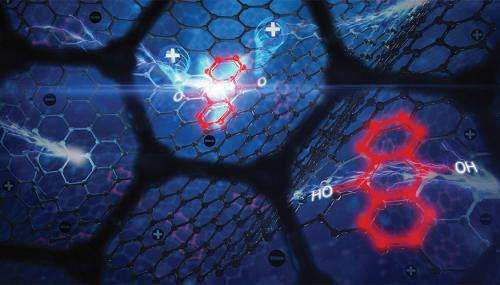Energy storage of the future

Personal electronics such as cell phones and laptops could get a boost from some of the lightest materials in the world.
Lawrence Livermore researchers have turned to graphene aerogel for enhanced electrical energy storage that eventually could be used to smooth out power fluctuations in the energy grid.
The team found that graphene aerogel-based supercapacitor electrodes could be particularly useful in the electric vehicle sector because they feature high surface area, good electrical conductivity, chemical inertness and long-term cycling stability.
Energy storage systems for electric vehicles have especially demanding requirements because they must combine high power and energy density, cyclability, safety and low cost. Supercapacitors (also known as ultracapacitors or electrical double-layer capacitors) can help to meet these requirements due to their high power density and excellent cycling stability.
"Commercial carbon-based supercapacitors are used to recover braking energy in numerous vehicles (cars, buses, trains, etc.) and to open the emergency exits of the Airbus A380," LLNL's Patrick Campbell said. "Our materials can potentially improve on the performance of these commercial supercapacitors by more than 100 percent."
Compared to traditional carbon-based supercapacitor electrodes fabricated from carbon black and binder materials, graphene aerogels offer many advantages such as control of density and pore size distribution, and increased conductivity due to carbon linkers between the active carbon sheets and the absence of binder materials.
Aerogels derived from carbon as well as inorganic materials were developed at LLNL and have found a number of applications—from capturing space dust to lining the inside of National Ignition Facility targets.
"Graphene aerogels are a relatively new type of aerogel that are ideal for energy storage applications because of their extremely high surface area, excellent mechanical properties and very high electrical conductivity," Campbell said. "We have been exploring various ways to enhance their energy storage properties such as increasing electrode density through mechanical compression. The non-covalent modification strategy is simply another route to increase the electrical energy storage capacity."
While use in personal electronics or other high-power applications where the energy needs to be stored and released very quickly has yet to be tested, the outlook is promising, said Juergen Biener, LLNL's team leader.
The research will appear as the cover article in the Nov. 14 issue of the Journal of Materials Chemistry A. Other Livermore researchers involved in the project include Brandon Wood, Marcus Worsley and Ted Baumann.
More information: J. Mater. Chem. A, 2014,2, 17694-17694. DOI: 10.1039/C4TA90174F
Journal information: Journal of Materials Chemistry A
Provided by Lawrence Livermore National Laboratory




















